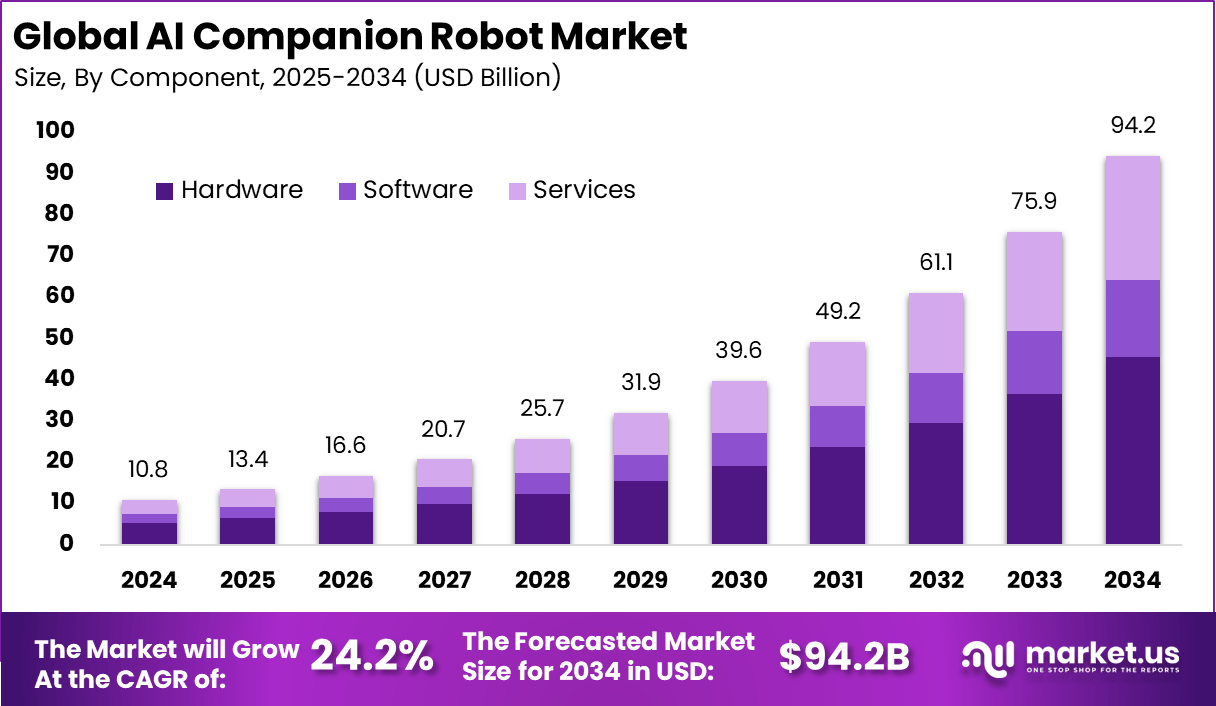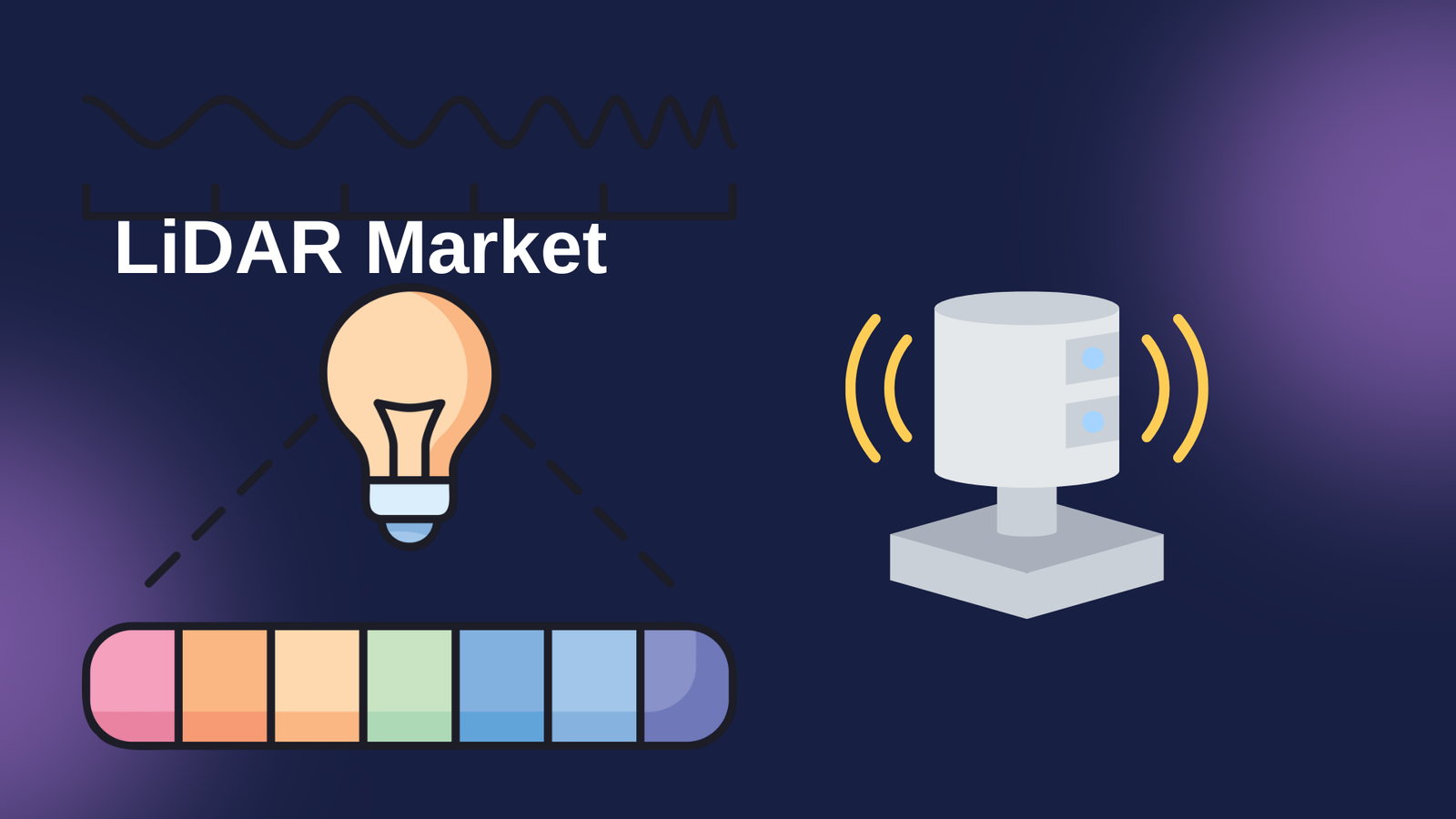AI Companion Robot Market Soar to USD 94.2 Bn By 2034
Updated · Aug 18, 2025

WHAT WE HAVE ON THIS PAGE
Introduction
According to Market.us, The Global AI Companion Robot Market is projected to grow from USD 10.8 billion in 2024 to approximately USD 94.2 billion by 2034, reflecting a robust compound annual growth rate of 24.2% during the forecast period from 2025 to 2034. In 2024, North America secured a dominant position in the market, accounting for more than 35.6% of the total share, with revenue reaching USD 3.8 billion. This leadership is supported by advanced technology adoption, strong research and development infrastructure, and early consumer acceptance of AI-driven personal assistance solutions.
The AI companion robot market encompasses robotic systems designed to provide emotional support, social interaction, assistance with daily activities, and personalized engagement. These robots integrate artificial intelligence, natural language capabilities, sensor systems, and user‑friendly interfaces. Their applications span elder care, mental wellness, personal assistance, and household support, particularly in environments where human companionship or care resources are limited.

Key Insights
- The global market is expected to grow from USD 10.8 billion in 2024 to USD 94.2 billion by 2034, registering a CAGR of 24.2%. Growth is driven by aging populations, advancements in robotics, and increasing demand for emotionally intelligent robotic care.
- North America led with a 35.6% share and USD 3.8 billion revenue in 2024, supported by strong healthcare innovation, a growing elderly population, and high adoption of consumer robotics.
- The U.S. market alone accounted for USD 3.66 billion in 2024, projected to grow at a CAGR of 23.1%, fueled by investments in AI-powered home care and personal assistance solutions.
- Hardware dominated the component segmentation with 48.2% share, driven by advancements in sensors, actuators, and humanoid designs enabling improved real-world interaction.
- Mobile robots led the mobility segment at 56.5%, reflecting their critical role in companionship, caregiving, and household assistance.
- Multimodal interaction was the leading interaction type with 38.7%, integrating voice, touch, gesture, and emotion recognition for more natural engagement.
- The elderly demographic formed the largest user group at 44.1%, as robots are increasingly used for emotional support, medication reminders, and daily living assistance.
- Elderly Care & Assisted Living was the top application at 29.4%, aimed at reducing loneliness and enhancing cognitive stimulation.
- Residential use accounted for 52.3% of the market, indicating growing acceptance of AI companions in personal and family settings.
Analysts’ Viewpoint
Top driving factors for this market include the increasing aging population worldwide, growing prevalence of loneliness and social isolation, and a rising demand for automated personal care and social interaction solutions. Advances in AI, machine learning, natural language processing, and sensor technologies are enabling more sophisticated robot capabilities that make these companions more relatable and useful. Additionally, the expanding adoption of connected smart home ecosystems and increased healthcare awareness contribute significantly to the growth of AI companion robot adoption.
The market is seeing increasing incorporation of cutting-edge technologies such as cloud-based AI learning, emotional intelligence algorithms, robotic process automation, and integration with Internet of Things devices. These innovations enable continuous improvement of robot capabilities, seamless interaction with other smart devices, and enhanced adaptation to individual needs. Robots are evolving beyond basic assistance to become proactive partners capable of anticipating needs and providing meaningful companionship.
Investment opportunities in this market arise from rapid technological innovation, increasing funding from both public and private sectors, and expanding use cases in healthcare, education, hospitality, and personal assistance. Regions with aging demographics, such as North America, Europe, and parts of Asia-Pacific, represent substantial market potential. The convergence of AI advances and growing consumer awareness creates favorable conditions for investments in research, development, and commercialization of new AI companion robot models.
Key Trends and Innovations
| Trend/Innovation | Description |
|---|---|
| Increased Personalization | AI companions adapt dynamically to individual emotional and physical needs, preferences, and behaviors. |
| Cloud-Based AI | Robots leverage cloud computing for continuous learning, updates, and enhanced processing power. |
| Emotional Intelligence | Enhanced emotion recognition and responsive behaviors improve human-robot interaction quality. |
| Multimodal Interaction | Combining voice, gesture, touch, and visual modalities for more natural and intuitive communication. |
| Integration with Healthcare Systems | Partnerships with health providers create tailored therapeutic and assistive solutions. |
| Robotics Hardware Miniaturization | Smaller, more affordable components leading to wider adoption and usability at home and care facilities. |
Driver Analysis
Aging Population and Technological Advancements
A principal driver fueling the AI companion robot market is the increasing global aging population, which creates heightened demand for caregiving solutions that go beyond traditional human resources. Elderly individuals often face isolation, mobility challenges, and chronic health conditions, driving the need for robots that offer companionship, medication reminders, and monitoring services.
In parallel, rapid technological advancements in AI, robotics hardware, sensor technologies, and cloud computing enable the development of more capable, affordable, and user-friendly companion robots. Innovations such as improved speech recognition, facial expression detection, and machine learning models empower robots to interact naturally and intuitively.
These technological strides also lower barriers for integrating companion robots in both home and institutional care environments. Furthermore, growing consumer awareness of mental health and well-being benefits, coupled with rising smart home adoption, fuels willingness to accept and invest in these solutions. Together, these factors contribute to strong market momentum and expanding applications beyond eldercare into childcare, therapy, and personal assistance.
Restraint Analysis
Data Privacy, Security Concerns, and High Costs
Despite promising growth, the AI companion robot market faces significant restraints related to data privacy and security. These robots process highly sensitive personal information, including health data and behavioral patterns, generating concerns about how data is collected, stored, and shared. Ensuring compliance with stringent regulations and building consumer trust in ethical robot behavior remain challenging.
Additionally, the complexity of designing robots capable of sophisticated emotional interactions while safeguarding user confidentiality adds development costs and operational hurdles. High initial purchase prices and maintenance costs further restrict widespread adoption, particularly among price-sensitive consumers and institutions.
Opportunity Analysis
Expansion in Healthcare, Elderly Care, and Emerging Markets
The AI companion robot market presents vast opportunities, particularly in healthcare and elderly care sectors where demand for personalized assistance is growing rapidly. Robots are increasingly adopted to support cognitive therapy, physical assistance, and emotional engagement, improving the quality of life for seniors and patients with chronic conditions. Institutional healthcare facilities and homecare providers are integrating AI companions to supplement caregiving staff and enhance patient outcomes.
Emerging markets such as Asia-Pacific and Latin America also offer substantial growth potential due to rising elderly populations, increasing disposable incomes, and expanding digital infrastructure. These regions are witnessing greater acceptance of assistive technologies, supported by government initiatives promoting smart health and aging-in-place solutions. Moreover, new application areas like childcare, education, and mental wellness further diversify market prospects, encouraging innovation in affordable, multifunctional companion robots.
Challenge Analysis
Building Consumer Trust and Overcoming Technical Limitations
A critical challenge for the AI companion robot market is building widespread consumer trust and addressing ethical concerns. Users must feel confident that robots handle sensitive data responsibly, provide reliable support, and act ethically in emotionally significant interactions. The risk of emotional dependence on AI companions and societal acceptance of robots as substitutes for human connection raise complex psychological and ethical issues.
Technically, limitations in current robotic design, such as imperfect speech recognition, limited natural movement, and occasional interaction glitches, can reduce user satisfaction and trust. Achieving realistic, engaging human-robot interaction remains a complex multidisciplinary endeavor requiring continuous advancement. Overcoming these challenges demands transparent communication, robust privacy safeguards, and iterative improvements driven by user feedback and interdisciplinary research.
Top Key Players
- SoftBank Robotics
- Furhat Robotics
- Hanson Robotics
- Intuition Robotics
- PARO Robots
- Sony Corporation
- Ubtech Robotics
- Hyodol
- Robot Care Systems
- Emotix
- No Isolation
- Shenzhen Yunzhixing Technology
- Blue Frog Robotics
- Skycatch
- Confluent Robotics
- Others
Source of Information – https://market.us/report/ai-companion-robot-market/
Sources

Rohan is a senior editor at Techno Trenz. He knows a lot about digital marketing, SEO, and social media optimization. Rohan is great at creating and editing detailed articles with accurate statistics that readers find useful. As a senior editor, he reviews and checks the quality of content from many writers before it is published. He also makes infographics to go with the statistics, making the information easier to understand and more engaging. Rohan's hard work ensures that Techno Trenz provides high-quality and informative content to its readers.










